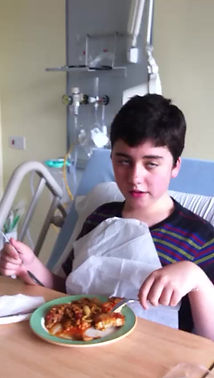AADCd Signs and Symptoms
A child suffering with AADC deficiency may have some or all of the following symptoms. Symptoms may vary as every child is different,
Quick Symptom Guide:
The most common symptoms are:
-
Low muscle tone, also called “hypotonia,” is the most common symptom.
-
Delays in development. A child with AADC Deficiency may be unable to lift and control his or her head, crawl, sit, or stand without support, walk, babble or say words
-
Many children with AADC Deficiency also have movement problems, including - involuntary eye movements (called oculogyric crises). These are moments when a child’s eyes suddenly roll upward involuntarily. They can last anywhere from a few seconds to hours, and can happen several times a day or several times a week. When this happens, it can look like the child is having a seizure.
Examples of Oculogyric Crisis in children with AADCd...

Here Jake is having an Oculogyric Crisis., without a dystonic attack.
Sofia suffers severe effects of the rare brain disease; Aromatic Amino Acid Decarboxylase Deficiency. Here she is suffering an Oculogyric Crisis, a frequent and painful symptom of this disease. Sofia is asking her mother to make them stop and make them go away. Sofia suffers dystonic attack with her Oculogyric Crisis
Children with AADC deficiency suffer multiple and profound disabilites. Almost all suffer with oculogyric crisis and in varying degrees. The worst attacks are suffered by severely affected AADCd children who can experience their oculogyric crisis with a dystonic attack which causes body stiffness and arching of the spine, this can last up to 8 hours and occur every 3 days.
Other involuntary movements, such as sudden jerking, flailing, or twisting.
Other common symptoms you might notice are excessive sweating, drooling, drooping eyelids, or a stuffy or runny nose.
These symptoms may also be present:
-
Seizures
-
Difficulty sleeping
-
Behavioral problems (like irritability or excessive crying)
-
Problems with digestion - diarrhea, constipation, reflux
-
Problems with feeding - trouble swallowing without choking or coughing
In Depth Symptom Guide:
AADC deficiency presents early in life with hypotonia, hypokinesia, oculogyric crisis, autonomic dysfunction, dysphoric mood, and sleep disturbance.
There may be a number of movement disorders, most frequently dystonia. Diurnal fluctuation and improvement of symptoms after sleep is a characteristic of AADC deficiency.
The majority of affected children show minimal motor development in the absence of treatment.
The presentation of symptoms varies in degrees of severity:
-
Neonatal Period
Feeding difficulties
Autonomic dysfunction
Hypotonia
-
Motor symptoms
Axial hypotonia (decreased tone or floppy - trunk, head and limbs)
Limb hypertonia (increased tone to the limbs)
Fluctuating limb tone
Hypokinesia (decreased spontaneous movements)
-
Oculogyric crises (a spasmodic attack and fixation of the eyeballs upwards)
-
Other movement disorders
Limb dystonia (disorder of muscle control)
Stimulus-provoked dystonia
Cervicofacial dystonia
Myoclonus/prominent startle
Distal chorea
Choreoathetosis
Athetosis
Parkinsonism
Flexor spasms
Tremor
Drug-induced dyskinesias
Chorea
Dystonia (disorder of muscle control)
-
Diurnal
Variation/improvement of neurologic symptoms after sleep
-
Autonomic dysfunction
Diaphoresis
Temperature instability
Nasal congestion
Ptosis/pupillary changes (droopy eyelids)
Hypotension/bradyarrhythmia
RAD/GI dysmotility (Gastrointestinal symptoms including gastroesophageal reflux, constipation, diarrhoea and dysmotility and absorption (inability to pass food through the gastrointestinal tract because muscles do not work properly),
-
Dysphoria
General feeling of unwell, unhappy and emotional lability
-
Sleep disturbance
